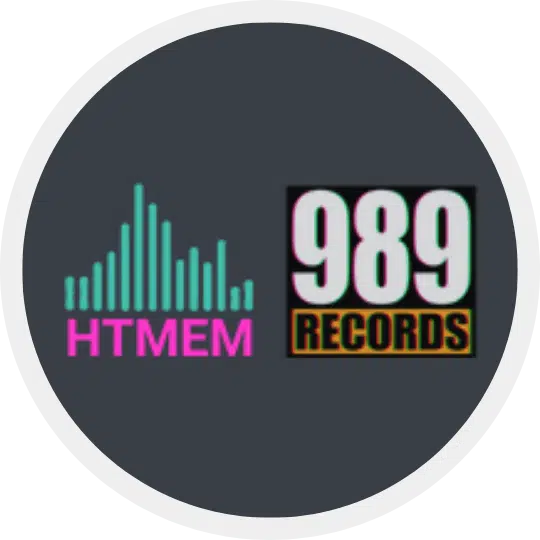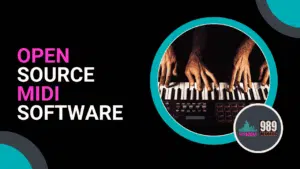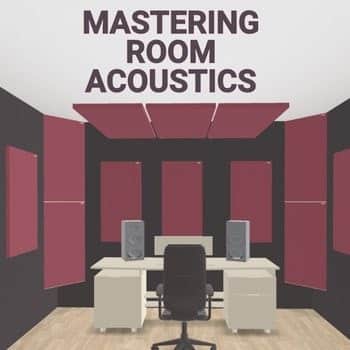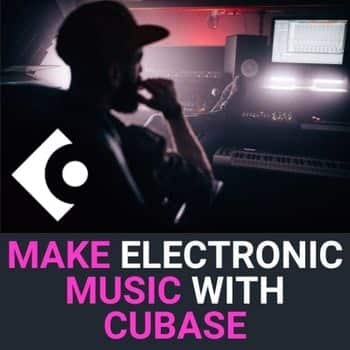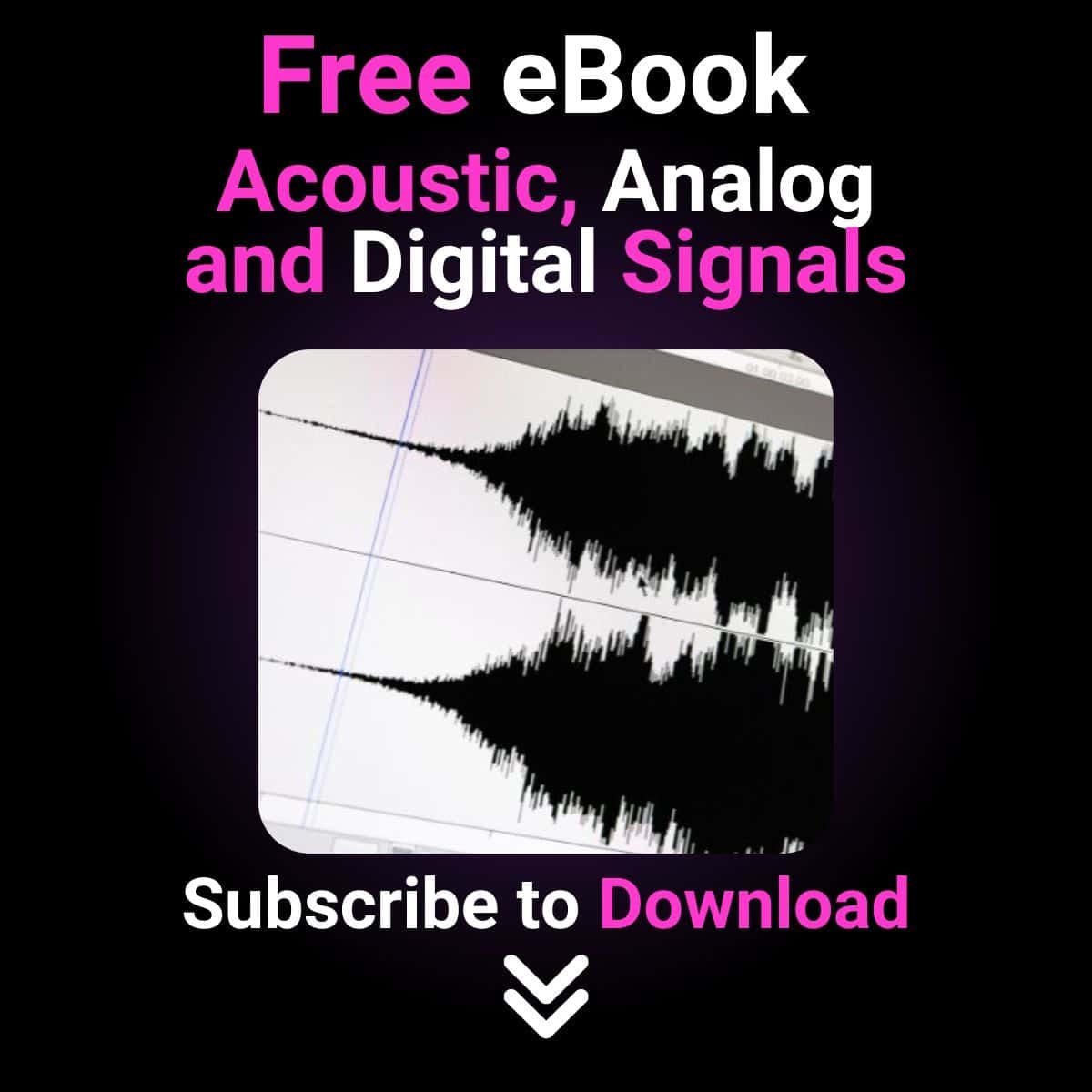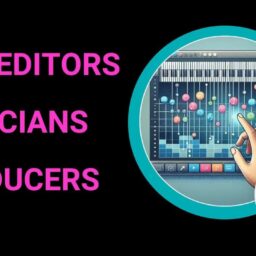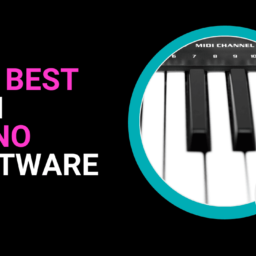In the world of music production, open-source MIDI software is a treasure trove for musicians, composers, and developers, offering virtual instruments and effects processors. With virtual instruments, you can compose, edit, and play MIDI files with ease. So if you’re a seasoned musician or just starting out, open-source MIDI software can help you bring your ideas to life.
Let’s get down to business now!
Introduction to Open Source MIDI Software
Open source MIDI software has revolutionized the music production industry, offering a cost-effective and flexible alternative to proprietary software. These tools empower musicians and producers to create, edit, and play MIDI files without the hefty price tag associated with commercial software. Whether you’re looking to compose intricate melodies, arrange complex sequences, or record high-quality audio, open source MIDI software provides a versatile solution.
One of the key advantages of open source MIDI software is its flexibility. With a wide range of options available, you can choose the software that best suits your needs. From powerful MIDI sequencers and editors to sophisticated music notation and audio recording tools, there’s something for everyone. These tools are designed to work seamlessly across different platforms, including Linux, making them accessible to a broad audience.
In this article, we will explore some of the best open source MIDI software available for Linux. We’ll delve into their features, benefits, and the vibrant user communities that support them. Whether you’re a seasoned professional or just starting out, these tools can help you bring your musical ideas to life.
What is Open Source MIDI Software?
Open source MIDI software is a cost-effective and flexible solution for music producers, composers, and musicians. Digital audio workstations (DAWs) are also a key component in this ecosystem. With many options to choose from, you can pick the software that fits your needs and workflow. From MIDI editors and sequencers to virtual instruments and effects processors, open source MIDI software has everything you need to create, edit, and record MIDI data.
In this article, we’ll look at some of the best open source MIDI software out there, including Hydrogen, Qtractor, Fx FloorBoard, FluidSynth, Impro-Visor, MuseScore, MidiLayer, and Frinika, to help you craft intricate soundscapes. Frinika, in particular, is a music workstation that features a sequencer and soft-synths, making it a complete solution for creating music.
Top Open Source MIDI Software for MIDI Files
- Hydrogen: A professional drum machine for GNU/Linux, Windows, and Mac OS X, Hydrogen is known for its pattern-based drum programming. A user-friendly tool to create complex drum patterns. Hydrogen is an advanced drum machine that offers robust features for musicians across platforms.
- Qtractor: An Audio/MIDI multi-track sequencer application written in C++ around the Qt framework, for Linux users. Qtractor uses Jack Audio Connection Kit (JACK) for audio and Advanced Linux Sound Architecture (ALSA) for MIDI, so it’s a great choice for those who need a robust sequencing solution.
- MuseScore: As the leading free and open-source music notation software, MuseScore is perfect for Windows, Mac, and Linux users who want to create beautiful sheet music. Easy to use and precise.
- FluidSynth: A real-time software synthesizer based on the SoundFont 2 specifications, FluidSynth is ideal for live audio synthesis of MIDI events or rendering MIDI files to disk using SoundFont instruments and effects processors. A great tool for musicians to explore different soundscapes.
- Impro-Visor: A music notation tool to produce monophonic lead sheets for improvisers. Impro-Visor auto-generates backing tracks, so it’s great for jazz musicians and composers.
MIDI Sequencer and Editors
- Aria Maestosa: A user-friendly MIDI sequencer/editor to compose, edit, and play MIDI files and digital audio with just a few clicks. Various views: score, keyboard, guitar, drum, controller. For musicians of all levels.
- Seq24: A standalone software sequencer for Windows and Linux. Native JACK MIDI and Windows support. A lightweight option for those who need a simple sequencer.
- Rosegarden: A free MIDI editor and sequencer for Linux. Piano roll editor and MIDI input and MIDI events. A comprehensive tool for detailed MIDI editing.
- MidiLayer: To enhance live performances, MidiLayer manages slots and channels, adjusts velocity and volume, customizes note range, and connects to modulation wheels and other controllers. It is compatible with MIDI controllers, making it an excellent choice for live musicians who want to enhance their performances.
- MidiSheetMusic: A free program that plays MIDI music files while highlighting the piano notes and sheet music notes. This tool is perfect for musicians who want to visualize their compositions in real-time.
Working with MIDI Files
MIDI files are a big part of music production, and working with them requires some understanding of MIDI software. A MIDI file is a file that contains MIDI data that can be used to control musical instruments, effects processors, and other MIDI compatible devices. To work with MIDI files, you need a MIDI sequencer or editor that can read, write, and edit MIDI data. Some popular MIDI software for working with MIDI files are Cubase, Ableton Live, FL Studio, and Logic Pro.
These software applications have advanced features like piano roll editors, music notation tools, and MIDI effects processors.
MIDI Utilities and Tools for Music Production
- VMPK: The Virtual MIDI Piano Keyboard is a cross-platform tool for Linux, Windows, and OSX, a MIDI event generator. It can generate MIDI events using a computer’s alphanumeric keyboard, making it a versatile tool for musicians who may not have access to a physical MIDI keyboard. It can also be used with virtual instruments for generating MIDI events. A rich understanding of music notation and basic support for digital audio. A valuable tool for any musician.
- Fx FloorBoard: A graphical editor software for various Boss and Roland effects and synth units. Visual editing of parameters via MIDI, USB, or Bluetooth. Essential for guitarists and synth enthusiasts. Check it out.
- GrandOrgue: A sample-based pipe organ simulator. Realistic sound and user-friendly interface. For musicians who want to simulate the grandeur of a real pipe organ in their compositions.
- Bristol: A synth emulation package with various vintage synthesizers, electric pianos, and organs. Bristol is great for musicians who want to explore retro sounds and incorporate them into their music, creating rich soundscapes.
Something More about the MIDI Protocol
MIDI, which stands for Musical Instrument Digital Interface, is a technical standard that describes a protocol, digital interface, and connectors. The MIDI protocol is crucial because it allows a wide variety of electronic musical instruments, computers, and other related devices to communicate and synchronize with each other. This protocol underpins the functionality of MIDI software by enabling the transfer of musical performance data between devices. Understanding the MIDI protocol is essential for anyone looking to fully utilize MIDI software, as it provides the technical foundation that makes these interactions possible.
MIDI Keyboard and Controller Support
A MIDI keyboard or controller is a must-have for music producers and musicians who work with MIDI software. A MIDI keyboard or controller allows you to input MIDI data into your software, which can then be used to control virtual instruments, effects processors, and other MIDI compatible devices. When choosing a MIDI keyboard or controller, consider the number of keys, type of controls, and compatibility with your MIDI software.
Some popular MIDI keyboards and controllers are the Akai MPK Mini, the Novation Launchkey, and the Korg MicroKEY. These devices have features like velocity-sensitive keys, pitch bend wheels, and assignable controls.
For your convenience, I’ve written an in-depth article here, which you might find helpful if you’re looking to gain a deeper understanding.
Getting Started with MIDI Software
- Choose the right MIDI software for your needs by considering MIDI sequencing, editing, and recording capabilities.
- Learn the basics of MIDI, including MIDI files, MIDI input, and MIDI events, to understand how to work with these tools.
- Familiarize yourself with the user interface and features of your chosen MIDI software, like piano roll editors and MIDI keyboard support.
- Experiment with different MIDI software to find the one that suits your music production needs.
MIDI Software Community and Support
The open source MIDI software community is vibrant and active, with many developers and users contributing to the creation and improvement of these tools. Online forums, social media groups, and dedicated websites provide a platform for users to share knowledge, ask questions, and collaborate on projects. This collaborative spirit helps users overcome the learning curve associated with new software, making it easier to get started and achieve their musical goals.
Many open source MIDI software projects offer extensive documentation, tutorials, and user manuals. For instance, the Qtractor manual spans over 200 pages, covering everything from basic usage to advanced features and customization. Similarly, the Aria Maestosa user manual provides a comprehensive guide to the software’s features and functionality. These resources are invaluable for new users, providing step-by-step instructions and troubleshooting tips.
Popular open source MIDI software projects often have large and active communities. For example, the MuseScore community boasts over 100,000 registered users, while the Hydrogen community has a dedicated forum with over 10,000 posts. These communities are a treasure trove of knowledge and support, offering everything from troubleshooting and bug reporting to feature requests and development discussions.
Overall, the open source MIDI software community is a valuable resource for musicians and producers. Whether you’re looking for technical support, creative inspiration, or collaboration opportunities, there’s a community out there ready to help. By tapping into these resources, you can enhance your music production skills and achieve your creative goals.
Advanced MIDI Recording Techniques
- Master MIDI sequencing and editing using techniques like quantization, velocity editing, and controller editing.
- Learn to use MIDI effects and processing tools like reverb, delay, and distortion to enhance your compositions.
- Experiment with advanced MIDI techniques like multiple MIDI tracks, complex MIDI patterns, and MIDI controllers to add depth to your music.
- Take advantage of MIDI software features like audio recording and MIDI recording to streamline your music production workflow.
Music Production Software
Music production software is a crucial tool for musicians, producers, and composers, enabling users to create, edit, and record music using various digital audio instruments and effects. In the context of MIDI software, music production software often includes features such as MIDI editing, sequencing, and recording. These tools allow you to manipulate MIDI data, control virtual instruments, and apply effects to your compositions, making the music production process more efficient and creative.
Whether you’re working on a complex orchestral arrangement or a simple electronic track, having the right music production software can make all the difference. With the ability to edit MIDI files, sequence MIDI events, and record audio, these tools provide a comprehensive solution for all your music production needs. From beginners to seasoned professionals, music production software offers a range of features that cater to different skill levels and creative requirements.
Integration with Digital Audio Workstations (DAWs)
Digital Audio Workstations, or DAWs, are software applications that facilitate the recording, editing, and mixing of audio files. Many DAWs also support MIDI editing and sequencing, making them a popular choice for music producers. When choosing MIDI software, it’s essential to consider its integration with DAWs. Some MIDI software is designed to work seamlessly with specific DAWs, while others may require additional setup or configuration. Cakewalk by Bandlab offers an easy way to work with MIDI and can be configured to focus on MIDI only, making it a versatile choice for producers.
Some popular DAWs that support MIDI editing and sequencing include:
- Cubase. Learn how to use it here
- Ableton Live
- FL Studio
- Logic Pro
- Pro Tools
Integrating MIDI software with a DAW offers numerous benefits:
- Enhanced Workflow: MIDI software can streamline the music production process by allowing users to focus on creating and editing MIDI data while the DAW handles audio recording and mixing.
- Increased Creativity: MIDI software provides a range of creative tools and features, such as virtual instruments, effects, and scoring tools, which can be used in conjunction with the DAW to create complex and engaging music productions.
- Improved Productivity: By integrating MIDI software with a DAW, users can work more efficiently, accessing all the tools and features they need in a single application.
This integration allows for a seamless transition between MIDI editing and audio recording, making it easier to bring your musical ideas to life and create memorable compositions.
Enhancing Workflow with MIDI Tools
MIDI tools are software applications that provide a range of features and functions for working with MIDI data. These tools can be used to enhance the workflow of music producers, composers, and musicians by offering creative and practical solutions for working with MIDI.
Some popular MIDI tools include:
- MIDI Editors: These tools allow users to edit and manipulate MIDI data, including notes, velocities, and controllers. They provide a detailed view of the MIDI data, making it easier to make precise adjustments.
- MIDI Sequencers: These tools enable users to create and arrange MIDI data in a linear or non-linear fashion. They are essential for composing and arranging music, allowing for the creation of complex MIDI patterns.
- MIDI Effects Processors: These tools provide a range of effects, such as reverb, delay, and distortion, which can be applied to MIDI data. They add depth and character to your compositions, enhancing the overall sound.
- MIDI Controllers: These tools allow users to control external MIDI devices, such as synthesizers and drum machines, using a computer or mobile device. They provide a hands-on approach to music production, making it easier to perform and record MIDI data.
Using MIDI tools offers several benefits:
- Increased Creativity: MIDI tools provide a range of creative solutions for working with MIDI data, including virtual instruments, effects, and scoring tools.
- Improved Productivity: MIDI tools can streamline the music production process by providing practical solutions for working with MIDI data.
- Enhanced Workflow: MIDI tools can enhance the workflow of music producers, composers, and musicians by offering features and functions that make it easier to create, edit, and record MIDI data.
In conclusion, music production software, integration with DAWs, and MIDI tools are essential components of the music production process. By understanding how these components work together, users can enhance their workflow, increase their creativity, and improve their productivity. Whether you’re a beginner or a professional, these tools can help you bring your musical ideas to life.
Comparison Table
Here is a sample comparison table:
| Software | Features | Platforms | Ease of Use |
|---|---|---|---|
| Hydrogen | Advanced drum machine, pattern-based programming | GNU/Linux, Windows, Mac OS X | User-friendly |
| Qtractor | Audio/MIDI multi-track sequencer uses JACK and ALSA for audio and MIDI | Linux | Moderate |
| MuseScore | Music notation software, intuitive interface for composing and arranging music | Windows, Mac, Linux | Easy |
| FluidSynth | Real-time software synthesizer, SoundFont 2 specifications | Cross-platform | Moderate |
| Impro-Visor | Music notation tool for monophonic lead sheets generates backing tracks automatically | Cross-platform | Moderate |
| Aria Maestosa | MIDI sequencer/editor, various views including score, keyboard, guitar, drum, and controller | Cross-platform | Easy |
| Seq24 | Standalone software sequencer, native JACK MIDI, and Windows support | Windows, Linux | Easy |
| Rosegarden | MIDI editor and sequencer, piano roll editor, supports MIDI input and events | Linux | Moderate |
| MidiLayer | Enhances live performances, manages slots and channels, connects with controllers | Cross-platform | Moderate |
| VMPK | Virtual MIDI Piano Keyboard, MIDI event generator | Linux, Windows, OSX | Easy |
| Fx FloorBoard | Graphical editor for Boss and Roland units, visual parameter editing via MIDI, USB, or Bluetooth | Cross-platform | Moderate |
| GrandOrgue | Sample-based pipe organ simulator, realistic sound | Cross-platform | Easy |
| Bristol | Synth emulation package, includes vintage synthesizers, electric pianos, and organs | Cross-platform | Moderate |
This table summarizes the features, platforms, and ease of use for each software so you can choose the right tool for your music production needs.
This (hopefully 😁) comprehensive guide to open-source MIDI software is for musicians and developers to create, edit, and play MIDI files efficiently.So many options out there, something for everyone. If you want to produce music, enhance live performances, or explore new soundscapes, do your research and choose.
So, explore the world of MIDI and find endless possibilities for your music production journey.
Professional Setup and Configuration
Audio Interface Configuration Essentials
Setting the buffer size to 256 samples for live performance is crucial to achieving the perfect balance between latency and system stability. When working with open-source MIDI software, this buffer setting gives you approximately 5.8ms of latency at 44.1kHz, which is imperceptible to most performers and ensures stable performance.
I’ve found through extensive testing in professional environments that this setting works great for live MIDI controllers and virtual instruments.
ASIO drivers on Windows systems are mandatory for professional MIDI work. Unlike standard Windows audio drivers, ASIO provides direct communication between your software and audio hardware, reducing latency and improving overall system stability. When working with clients, I always ensure their systems are configured with the latest ASIO drivers, preferably the manufacturer’s native drivers rather than generic ASIO4ALL, though the latter can work well in budget setups.
Enabling real-time priority for the JACK Audio Connection Kit is a critical step often forgotten by beginners. JACK’s real-time priority ensures that audio processes take precedence over other system tasks, virtually eliminating buffer underruns and audio dropouts. On Linux systems, this requires proper user group configuration and system limit adjustment. I recommend setting the real-time priority to 70, which I’ve found works great across various hardware configurations.
If you’re not familiar with driver buffer sizes and digital audio theory, I’ve created a course that explains acoustic, analog, and digital signals to help you get the best results from your recordings. Check it out here
MIDI Controller Integration Strategies
Hardware MIDI thru setup requires attention to avoid timing issues and data loops. When setting up multiple MIDI devices, proper MIDI thru setup ensures timing information is consistent across all devices in the chain.
I recommend using hardware MIDI thru like the Emagic AMT-8 over software-based solutions when possible as it gives more reliable timing and lower latency. For complex setups, I suggest using a dedicated MIDI patchbay or interface with multiple MIDI ports rather than daisy-chaining devices.
MIDI learn is a powerful feature that should be set up thoughtfully for each project. When setting up MIDI learn, consider the ergonomics of your performance or production setup. I recommend creating a template that maps essential controls to easily accessible parameters on your controller.
For example, in my live performance setup, I always map filter cutoff to easily accessible knobs and volume faders to long-throw faders for precise control.
Custom MIDI mappings deserve special attention as they can greatly improve your workflow. Based on my experience training professionals, I recommend creating context-specific mappings for different stages of your production process.
For example, having one mapping layout for recording sessions and another for mixing can speed up your workflow significantly. Document your mappings and save them as part of your project templates.
And, Since a new feature is available from Cubase 12 called MIDI Remote, the DAW allows you to map your external controller with ease. I explain everything in detail on my Cubase Course.
Troubleshooting Complex Systems
Latency issues require a systematic approach to diagnosis and resolution.
Start by measuring your system’s actual latency using tools like RTL Utility on Linux or LatencyMon on Windows. Monitor your system’s performance while running your MIDI software, and look for CPU spikes and disk activity.
I’ve found that many latency issues come from background processes or power management settings rather than the MIDI software itself.
The buffer size should be adjusted according to your use case.
- For recording, you can use larger buffers (512 or 1024 samples) to reduce CPU load without affecting the recording quality.
- For live performance with virtual instruments, use buffers 256 or lower to keep it responsive.
When working with multiple virtual instruments, consider freezing tracks or bouncing to audio to reduce system load.
MIDI interface drivers should be updated regularly and properly configured. In my training sessions, I often find issues that come from outdated or incorrectly installed drivers. Make sure your interface firmware is up to date and you’re using the manufacturer’s latest drivers.
On Windows systems, disable USB power management for MIDI interfaces to prevent sleep-related issues.
System monitoring is key. Use your operating system’s resource monitor to watch CPU, disk activity, and memory usage. I recommend keeping the CPU below 70% during peak load to maintain stability. Look for processes that might interfere with MIDI timing, such as background updates or virus scans.
Version Control and Project Management
When working with open-source MIDI software, version consistency across all components is critical. I recommend creating a detailed log of your software versions, applications, plugins, and any additional tools. This documentation is gold when troubleshooting or recreating a working setup.
Software updates, including firmware updates, should be approached with caution in a production environment. Always test new versions in a separate environment before updating your main production setup.
Keep backups of working configurations and have a rollback strategy for critical components. This has saved me hours of troubleshooting in professional environments.
Optimization Best Practices
System optimization goes beyond software settings. Regular OS maintenance, managing startup programs, and optimizing disk performance all contribute to stable MIDI performance.
On Windows, I recommend using the High Performance power plan and disabling unnecessary services.
On Linux, use a real-time kernel, and it will give you a huge boost for MIDI timing.
Conclusion
Open-source MIDI software is a versatile and affordable solution for musicians and composers of all levels. Whether you want to create intricate drum patterns, compose beautiful sheet music, or explore vintage synthesizers.
Suggested Reading
The Best MIDI Piano Software for Seamless Music Creation and Editing
Practice and Enjoy
